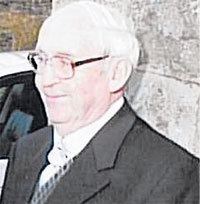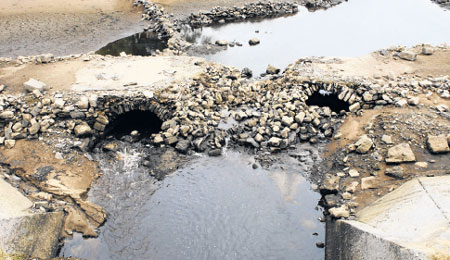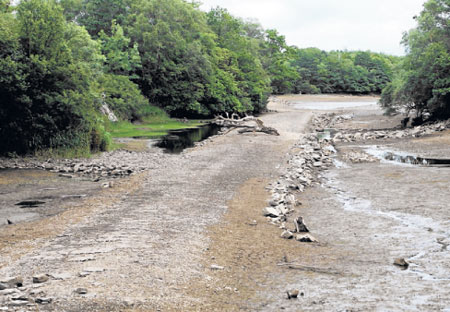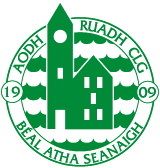Corlea resurfaces as Assaroe Lake reveals its secrets
By Michelle Nic Phaidin
Photos by Thomas Gallagher
This article appeared first in the Donegal Democrat 9 October 2008 edition and is reproduced here by kind permission.
 As the water ebbed, the memories emerged. Standing on the banks of the flooded pitch, that gave us some of the best football games in the county, you can almost catch a glimpse of the past in the silvery surface of Assaroe lake in the townland of Corlea.
As the water ebbed, the memories emerged. Standing on the banks of the flooded pitch, that gave us some of the best football games in the county, you can almost catch a glimpse of the past in the silvery surface of Assaroe lake in the townland of Corlea.
The Corlea football pitch became the man made Assaroe lake in 1957. In recent days the water level was at the lowest it had been in years and people who had fond memories, people stood on the crooked bridge and remembered days long since past, saw those memories come back to life, if only fleetingly.
Lying along the banks of the football pitch men jumped to their feet and shouted frantically supporting their home teams. The atmosphere at fever pitch, the young boys stood by their father's side in wonderment, their eyes squinting in the sunlight watching their father's excitement in awe and delight.

Corlea GAA pitch, which was revealed at the Knather, Ballyshannon when the Assaroe Lake between Cathleen's Falll and Cliff Hydro Stations was lowered for maintenance work to be carried out.
It was on the sloping banks of this field that many fathers and sons forged memories.
Now the brambles cling and claw at your ankles as you walk to the earthen banks that once was home to the matches but for people like Willie McLaughlin the submerged memories lie in his mind.
Willie has a paradoxical affiliation with the lake, he played and refereed on the pitches, in later years worked with ‘Cementation' the company that was instrumental in turning it into a lake for ESB purposes and in later years fished on it.
In 1925 he came to Corlea and lived beside the pitch. Now in his 80's, his blue eyes become distant when asked about the history of the lake.
He says: "The lake is about 100 yards long, the size of a football field. There was a lot of teams that played on the field, Donegal Town, Ballyshannon, Gaoth Dobhair, Corlea and many more.

The Old Corlea Bridge.
"We were a junior club in 1947 and we won the junior championship. On an average football day there would be a couple of hundred people standing around the pitch. In the 1930's five townlands transferred from Fermanagh into Donegal and that time many games were played here. Hugh Daly was the secretary of the club back then. He was a good player himself."
He recalls that players who later for Donegal started out on the pitch and there were other players that didn't make it onto the Donegal team but were chosen to play elsewhere.
He says: "I remember taking Yanky Tommy down for a trial and for the Donegal team. He was told that he wasn't fit to play for Donegal but later came back from America playing full back with the New York team. They played the Cavan team and Peter Donoghue never got a shot of the ball. Patsy Rooney who played for Fermanagh and Donegal came from a Corlea family. We played a lot of seven asides as well and tournaments. That pitch was where players trained for the final. Ballyshannon were a big club and there was a lot of rivalry between them and Corlea."
Willie is delighted that people caught a glimpse of what lies beneath the lake in recent days. The historical stories of the area were once again brought to surface as people stood along the two hundred year old crooked bridge, watching the waters ebb away from what was a training ground for the greats of the past. He said: "Everybody was coming to look at the lake when the water was low. It was great for people who remembered it before it was flooded."
He remembers how well the players were treated back then. He recalls: "We used to buy their boots and their togs. We were the best customers Elverys in Dublin had."
During the 1930's Corlea Hall opened. It was the ballroom of romance or as some might have called it the ballroom of no chance at the time.
Some locals remember the Ballyshannon boys and the Corlea boys marking the opening with a fight that started at the door of the hall down towards the crooked bridge.
The hall became the first GAA centre in that region of Donegal. It also played host to some excellent dramas that were put on the stage by people who lived in the surrounding area. The Border players became known far and wide for the great dramas that were being staged in the Corlea Hall.

The old Knather/Corlea Road which was revealed at the Knather, Ballyshannon.
Willie says: "Hugh Daly was a good actor for all them plays." During the 1930's, 40's and 50's due to emigration people began to leave the picturesque townland of Corlea but now Willie is glad to see that the re-emergence of a close knit traditional community once again in the area.
He says: "It is like the lost world is re-emerging. A lot of new homes are being built in the area."
A spokesperson for the ESB in Ballyshannon said that the work which was being done in the Corlea region, which caused the low water level, has now finished and people will have to wait a while before they get the opportunity, to once again, catch a glimpse into the past like they have in recent days.


